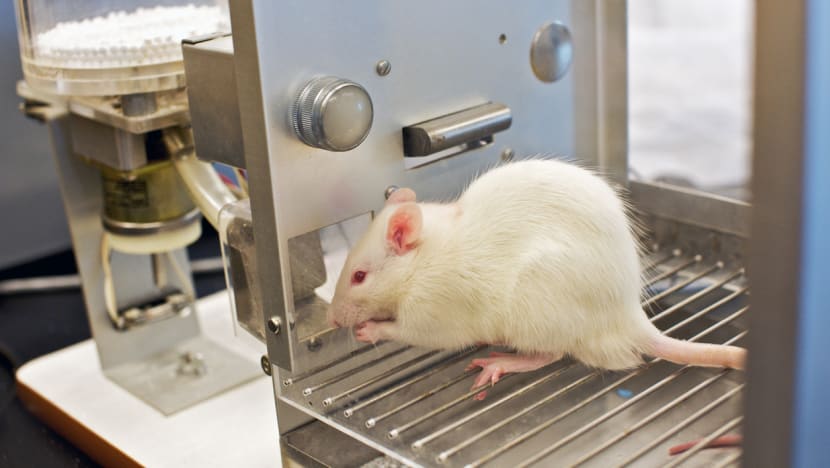Commentary: Human mini-brains were transplanted into rats. Is this ethical?
Human-animal chimeras were science fiction in 1958. They are a reality today and the ethics must keep pace with the science, says NUS Medicine’s Professor Julian Savulescu.

An undated handout picture released by Standford University on Oct 12, 2022 shows the brain of a rat in which a fluorescent protein has been used to highlight transplanted human brain cells. (Photo: AFP/Sergiu Pasca/Stanford University)
SINGAPORE: In the 1958 horror film, The Fly, a scientist is experimenting with an atomic transporter. A fly enters his laboratory and his atoms get mixed up with the fly, turning him into a monstrous creature part fly, part human.
Human-animal chimeras were science fiction in 1958. They are a reality today.
ARE 'HUMANISED RATS' JUST RATS?
In a world-first, scientists have transplanted human brain cells into the brains of baby rats, offering immense possibilities to study and develop treatment for neurological and psychiatric conditions.
The human brain tissue, known as brain organoids or “mini-organs”, are independent nerve structures grown in a lab from a person’s cells, such as their skin cells, using stem cell technology. Although they can’t yet replicate a full brain, they resemble features or parts of an embryonic human brain.
The study, published in the journal Nature on Oct 12, showed that the human organoids integrated into the rat brain and function, and were even capable of affecting the behaviour of the rats.
A few months later, up to one-sixth of the rat cortex was human. In terms of their biology, they were “humanised rats”.

This is an exciting discovery for science. It will allow brain organoids to grow bigger than they have in a lab, and opens up many possibilities of understanding how early human neurons develop and form the brain, and what goes wrong in disease. It also raises the possibility of organoids being used to treat brain injury.
Indeed, the rat models showed the neuronal defects related to one rare severe disease called Timothy Syndrome, a genetic condition that affects brain development and causes severe autism.
This is one step further along the long road to making progress in brain disease, which has proved so intransigent so far.
The research must go ahead. But at the same time, it calls for new standards to be set for future research. At present, the research raises no significant new ethical issues. However, it opens the door to more elaborate or ambitious research that could raise significant ethical issues.
MORAL STATUS OF ANIMALS WITH HUMAN TISSUE
The human tissue transplanted into the rats’ brains were in a region that processes sensory information such as touch and pain.
These organoids did not increase the capacities of the rats. But as larger organoids are introduced, or organoids are introduced affecting more key areas of the brain, the rat brain may acquire more advanced consciousness, including higher rational capacities or self-consciousness.
This would raise issues of how such “enhanced” rats ought to be treated. It would be important to not treat them as rats, just because they look like rats, if their brains are significantly enhanced.
This requires discussion and boundaries set around what kinds of organoids can be implanted and what key sites would be targets for enhancement of capacities that matter to moral status.
It also requires us to decide what confers moral status. This is a combined scientific and ethical challenge. Whether they could ever be “humanised” in ethical terms of capacity for defining human functions (such as ability to make moral judgements or responsibility for their actions) is an open question.
If this technology progresses, it will be tempting to move this research to primates, which are closer to humans than rats. However, because primates are so much closer to us in biological terms, it would be easier to tip their moral status over into full human moral status, or be fully “ethically humanised.”
Several factors would determine how likely this is: The size of the brain, how early in development of the recipient the organoid is transplanted, the size of the organoid and the areas of the recipient brain which it affects.
A NEW KIND OF SLAVERY?
The new research arrives against a backdrop of radical genetic modification of animals for our purposes.
For decades, animals have been genetically modified to suffer from human diseases. Mouse models have provided insight into human cancer, heart disease, diabetes, obesity, osteoporosis, glaucoma, neurodegenerative disorders such as Alzheimer's disease and more.
Indeed, recently a genetically modified pig heart was transplanted into a human, David Bennett, but he died after two months.
Stem cell technology and genetic engineering have been used to create human organs such as liver and pancreas in pig-human chimeras, with the hope of transplanting these organs to humans.
We are in the midst of a biological revolution harnessing the engine of biology to serve our needs. We are even creating life synthetically.
But does this risk instrumentalising and subjugating animals and new life forms to our own interests as slaves?
The issue of moral status has always been urgent, but it is more urgent than ever. The new kinds of slavery may be invisible because they involve life so different from us, and so different from what has preceded us.
Many people will be tempted to discount the moral status of these new life forms. After all, aren’t these organoids just derived from skin cells?
The origin of a neuron, brain or person does not matter morally. It does not matter whether they are natural or artificial, carbon-based or silicon-based.
What matters morally is function. Firstly, consciousness is necessary for moral status. It doesn’t matter how you treat a rock. It matters how you treat a rat.
As Jeremy Bentham said in 1789: 'The question is not "Can they reason?" nor "Can they talk?", but "Can they suffer?" Why should the law refuse its protection to any sensitive being?'
The key point is that if function, not structure, matters, it is necessary to test the behaviour and mental functions of new life forms before they are sacrificed for human purposes.
THE FAR FUTURE: INVISIBLE CLONES?
Brain organoids are a clone of an existing human person. They take a person’s genetic programme from a skin cell and build a brain from that.
What matters fundamentally is what happens in our minds. This is caused by activity in our brains. If brain organoid research were to progress and substantial parts of key areas of, say, primate brains were replaced with a clone of an existing person’s brain, then a novel ethical problem arises: We would have created a clone of a person inside an animal’s body.
Most countries have stringent laws on creation of clones, gene editing and chimeras. But these ingenious experiments may take a different path than those anticipated in these laws, which rapidly become outdated.
Previous laws anticipated ethical issues around tissue as it related to the tissue’s owner, not to the interests of the tissue itself. Other laws related to embryonic stem cells, but not those generated from skin cells.
Cloning laws were formed at the time of nuclear transfer technology, not used in these experiments. It is essential that ethics keeps pace with science. Science and ethics must work together.
Professor Julian Savulescu is Director, Centre for Biomedical Ethics at the Yong Loo Lin School of Medicine, National University of Singapore.


















